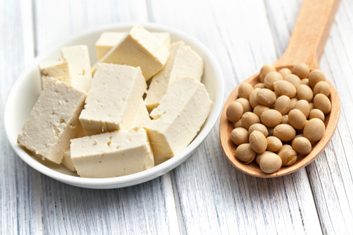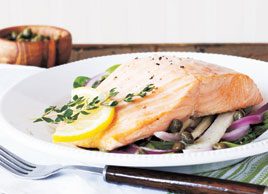
Add calcium-rich foods to your diet
A diet without milk products can cause people with lactose intolerance to miss out on calcium, but deficiencies can easily be avoided. “There are many other options for foods that contain calcium without the lactose,” says Melissa LeBlanc, a Vancouver-based registered dietitian and nutrition consultant with Everyday Nutrition. LeBlanc recommends:
Tofu (made with calcium sulphate) – 347 mg calcium/150g serving
Tofu (firm or extra firm made with calcium sulphate and magnesium chloride) – 234 mg calcium/150 serving
White beans – 119 mg calcium/ ¾ cup serving
Tahini (sesame paste) – 130 mg calcium/ 2 tbsp serving
Almonds (dry roasted) – 93 mg calcium/ ¼ cup serving
Sardines (Atlantic canned with the bones) – 286 mg calcium/75 g serving
Salmon (canned with bones) – 208 mg calcium/75 g serving
Spinach has also been applauded for its calcium content, but LeBlanc points out that the green vegetable boasts oxalic acid, which interferes with calcium absorption. If you’re looking for calcium-rich green veggies, she suggests trying cooked bok choy (84 mg calcium/ ½ cup serving), or cooked kale (49 mg calcium/ ½ cup serving) as wiser options.
Non-dairy drinks such as a fortified rice or soy beverage (319 mg calcium/ 1 cup serving), or a calcium and vitamin D fortified orange juice (185 mg calcium/ ½ cup serving) can also help you meet daily calcium requirements. Health Canada says that adults from 19 to 50 years of age should have a recommended dietary allowance (RDA) of 1,000 mg of calcium per day.

Boost your health with calcium supplements
If you fear that your diet isn’t providing enough calcium, Dr. Desmond Leddin, a Board Member of the Canadian Digestive Health Foundation, recommends taking 1g of calcium in a supplement. All Canadian adults between the ages of 19 to 50 should be aware that consuming more than 2,500 mg of calcium per day could raise their risk of kidney stones.

Don’t forget vitamin D
Milk products also contain plenty of vitamin D, and a lactose intolerant individual needs to pick up this vitamin from other sources. The sun is the most powerful source, but there are some food sources as well. According to LeBlanc, “very few foods contain large amounts of vitamin D, but canned or cooked fatty fish are a good source of vitamin D.” She recommends:
Salmon (pink, canned) – 435 IU vitamin D/ 75 g serving
Skipjack tuna (cooked) – 381 IU vitamin D/ 75 g serving
Salmon (Atlantic cooked) – 246 IU vitamin D/ 75 g serving
Salmon (Sockeye, canned) – 585 IU vitamin D/ 75 g serving
Sardines (Pacific, canned) – 360 IU vitamin D/ 75 g serving
Trout (cooked) – 210 IU vitamin D/ 75 g serving
LeBlanc also says that egg yolk is a healthy source of vitamin D (25 IU vitamin D/ 1 egg).
Not sure if your diet is providing enough vitamin D? Leddin says that a supplement containing 400 units of vitamin D can help tackle a deficiency. Health Canada says children and adults age 9 to 70 should get 600 IU (15 mcg) of vitamin D per day. Vitamin D amounts over 4,000 IU (100 mcg) should be avoided due to adverse health effects.

Keep a food diary
Lactose intolerance is different for every sufferer. Many people go through trial and error to discover what they can – and can’t – consume. Keeping a food diary on paper, or in your smartphone can help you discover how much lactose you can tolerate. “People can usually figure it out pretty quickly,” says Leddin. For individuals who want to track their diet and symptoms wherever they may be, The Canadian Digestive Health Foundation has created a free iPhone and Android app called GI BodyGuard. Conveniently record your meals, medications and symptoms and have the information at hand to show your doctor.

Try having milk with meals
Leddin says that some people find that consuming small amounts of milk products with meals makes it easier to tolerate lactose. When minimal amounts of dairy products are digested at the same time as your meal, the enzyme in your bowel receives the lactose in a small trickle, making it easier to break down. Taking in large amounts of lactose on their own can have the opposite effect, overwhelming the enzyme in the bowel, and creating uncomfortable symptoms such as cramps and diarrhea.

Try enzyme drops
Over-the-counter enzyme drops could help some individuals eliminate painful symptoms. Just add the drops to your milk 24 hours before you want to drink it, and the enzymes will break down and reduce the lactose in the dairy product, making it less likely that you’ll experience symptoms of intolerance.
Related:
• 5 milk alternatives to try if you’re lactose intolerant
• 8 ways to get calcium if you’re lactose intolerant
• 6 surprising health benefits of calcium
